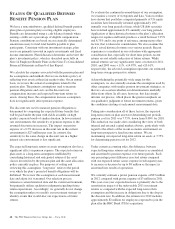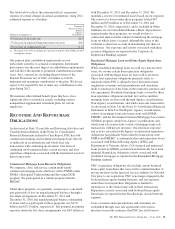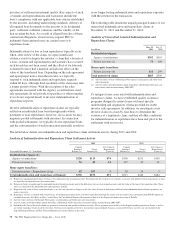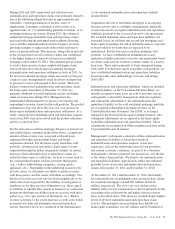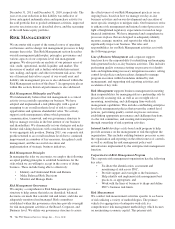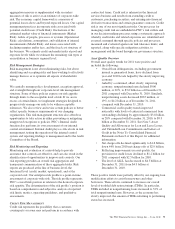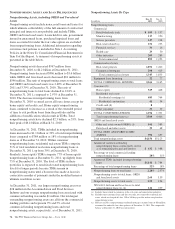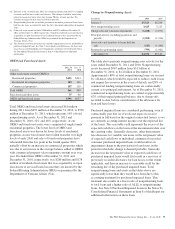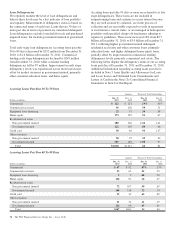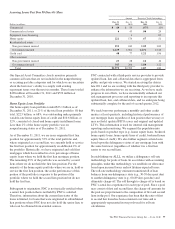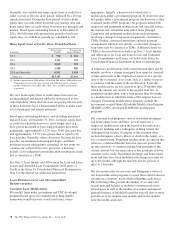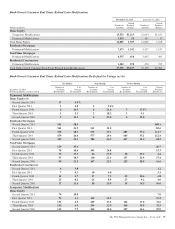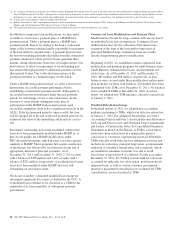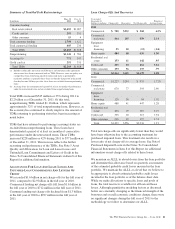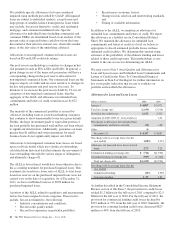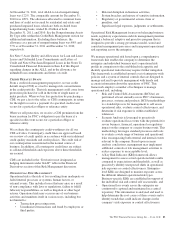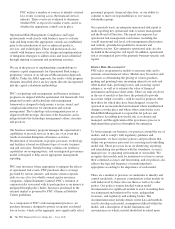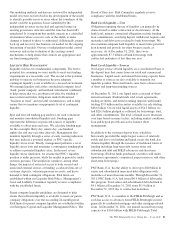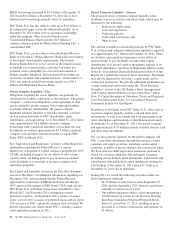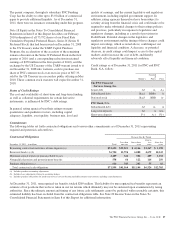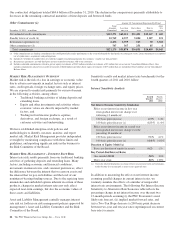PNC Bank 2011 Annual Report Download - page 87
Download and view the complete annual report
Please find page 87 of the 2011 PNC Bank annual report below. You can navigate through the pages in the report by either clicking on the pages listed below, or by using the keyword search tool below to find specific information within the annual report.
Generally, our variable-rate home equity lines of credit have
either a seven or ten year draw period, followed by a 20 year
amortization term. During the draw period, we have home
equity lines of credit where borrowers pay interest only and
home equity lines of credit where borrowers pay principal and
interest. Based upon outstanding balances at December 31,
2011, the following table presents the periods when home
equity lines of credit draw periods are scheduled to end.
Home Equity Lines of Credit - Draw Period End Dates
In millions
Interest Only
Product
Principal and
Interest Product
2012 $ 904 $ 266
2013 1,211 331
2014 2,043 598
2015 1,988 820
2016 and thereafter 6,961 5,601
Total (a) $13,107 $7,616
(a) Includes approximately $306 million, $44 million, $60 million, $100 million, and
$246 million of home equity lines of credit with balloon payments with draw
periods scheduled to end in 2012, 2013, 2014, 2015, and 2016 and thereafter,
respectively.
We view home equity lines of credit where borrowers are
paying principal and interest under the draw period as less
risky than those where the borrowers are paying interest only,
as these borrowers have a demonstrated ability to make some
level of principal and interest payments.
Based upon outstanding balances, and excluding purchased
impaired loans, at December 31, 2011, for home equity lines
of credit for which the borrower can no longer draw (e.g.,
draw period has ended or borrowing privileges have been
terminated), approximately 4.32% were 30-89 days past due
and approximately 5.57% were greater than or equal to 90
days past due. Generally, when a borrower becomes 60 days
past due, we terminate borrowing privileges, and those
privileges are not subsequently reinstated. At that point, we
continue our collection/recovery processes, which may
include a loss mitigation loan modification resulting in a loan
that is classified as a TDR.
See Note 5 Asset Quality and Allowances for Loan and Lease
Losses and Unfunded Loan Commitments and Letters of
Credit in the Notes To Consolidated Financial Statements in
Item 8 of this Report for additional information.
L
OAN
M
ODIFICATIONS AND
T
ROUBLED
D
EBT
R
ESTRUCTURINGS
Consumer Loan Modifications
We modify loans under government and PNC-developed
programs based upon our commitment to help eligible
homeowners and borrowers avoid foreclosure, where
appropriate. Initially, a borrower is evaluated for a
modification under a government program. If a borrower does
not qualify under a government program, the borrower is then
evaluated under a PNC program. Our programs utilize both
temporary and permanent modifications and typically reduce
the interest rate, extend the term and/or defer principal.
Temporary and permanent modifications under programs
involving a change to loan terms are generally classified as
TDRs. Further, certain payment plans and trial payment
arrangements which do not include a contractual change to
loan terms may be classified as TDRs. Additional detail on
TDRs is discussed below as well as in Note 5 Asset Quality
and Allowances for Loan and Lease Losses and Unfunded
Loan Commitments and Letters of Credit in the Notes To
Consolidated Financial Statements in Item 8 of this Report.
A temporary modification, with a term between three and 60
months, involves a change in original loan terms for a period
of time and reverts to the original loan terms as of a specific
date or the occurrence of an event, such as a failure to pay in
accordance with the terms of the modification. Typically,
these modifications are for a period of up to 24 months after
which the interest rate reverts to the original loan rate. A
permanent modification, with a term greater than 60 months,
is a modification in which the terms of the original loan are
changed. Permanent modifications primarily include the
government-created Home Affordable Modification Program
(HAMP) or PNC-developed HAMP-like modification
programs.
For consumer loan programs, such as residential mortgages
and home equity loans and lines, we will enter into a
temporary modification when the borrower has indicated a
temporary hardship and a willingness to bring current the
delinquent loan balance. Examples of this situation often
include delinquency due to illness or death in the family, or a
loss of employment. Permanent modifications are entered into
when it is confirmed that the borrower does not possess the
income necessary to continue making loan payments at the
current amount, but our expectation is that payments at lower
amounts can be made. Residential mortgage and home equity
loans and lines have been modified with changes in terms for
up to 60 months, although the majority involve periods of
three to 24 months.
We also monitor the success rates and delinquency status of
our loan modification programs to assess their effectiveness in
serving our customers’ needs while mitigating credit losses.
The following tables provide the number of accounts and
unpaid principal balance of modified consumer real estate
related loans as well as the number of accounts and unpaid
principal balance of modified loans that were 60 days or more
past due as of six months, nine months and twelve months
after the modification date.
78 The PNC Financial Services Group, Inc. – Form 10-K


